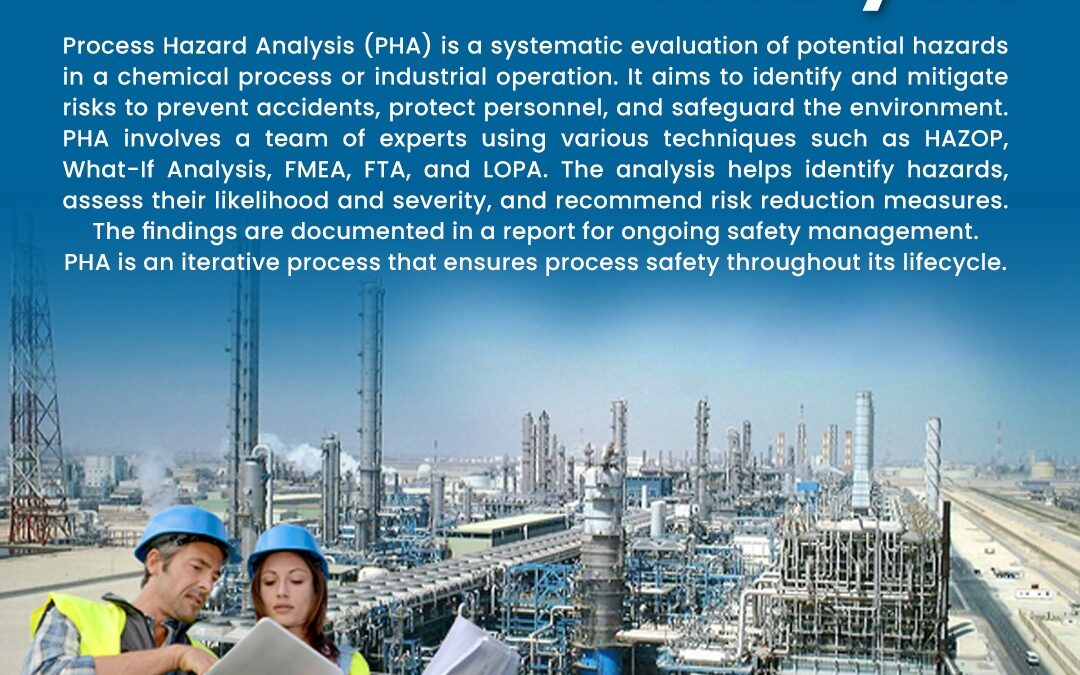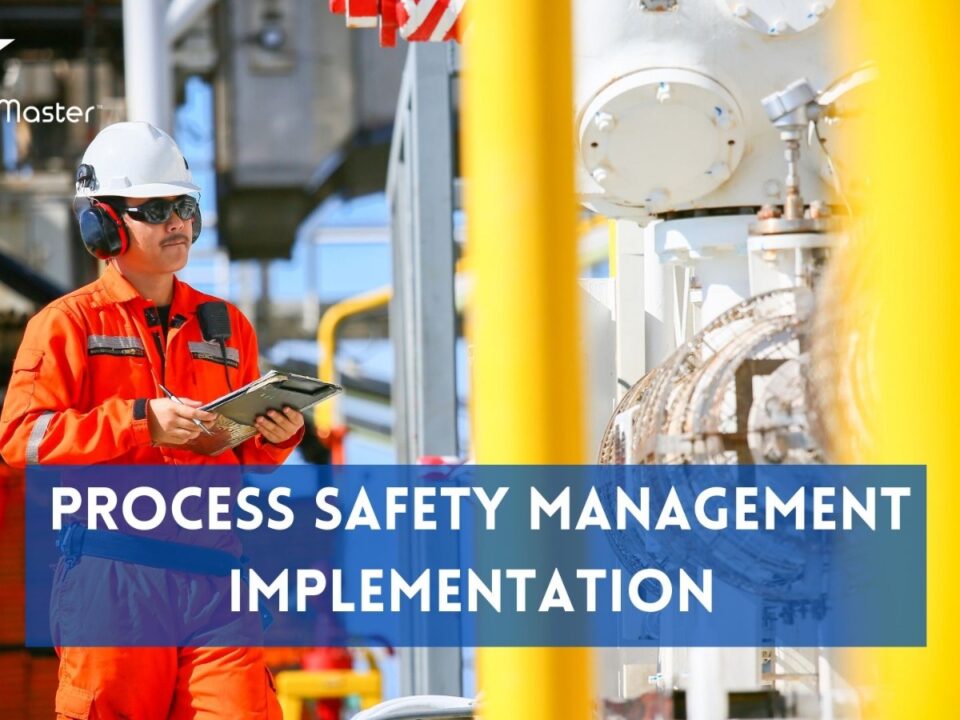A Comprehensive Guide to Process Hazard Analysis

Exploring the Different Classes and Zones of Hazardous Area Classification
May 31, 2023
Demystifying Fire Explosions: A Comprehensive Look at Flammable Gases and Their Properties
June 2, 2023A Comprehensive Guide to Process Hazard Analysis
In this article, we will explore an essential aspect of industrial safety: Process Hazard Analysis. At the core of every industrial operations lie hazards that pose significant risks to workers’ safety and plant operations. Process Hazard Analysis is a systematic approach that identifies and mitigates potential hazards in industrial operations. Our comprehensive guide will delve into the fundamentals of Process Hazard Analysis, its benefits, and the best practices to implement it successfully. By the time you finish reading, you will have gained the knowledge and skills that will enable you to keep your plant operations safe and efficient. In today’s fast-paced industrial world, safety is paramount, and Process Hazard Analysis plays a crucial role in ensuring that industrial operations achieve safety, reliability, and efficiency. Let’s dive in!
Introduction
Process Hazard Analysis (PHA) is an essential element in the safe and effective operation of any industrial process. With the potential for catastrophic events, such as explosions, fires, and toxic releases, it is critical that companies understand the risks associated with their operations and take steps to manage them. The purpose of this article is to provide a comprehensive guide to Process Hazard Analysis techniques, including identifying and analyzing hazards and evaluating and managing risks. Readers can expect a highly detailed article that covers all aspects of Process Hazard Analysis. From defining PHA to implementing recommendations from the analysis process, this guide will provide readers with a complete understanding of how to ensure safe operations within their facilities. Additionally, readers can anticipate learning about continuous improvement methods aimed at refining PHA processes for ongoing safety in operations.
What is Process Hazard Analysis?
Process Hazard Analysis (PHA) is a critical tool used to identify, analyze, and evaluate potential hazards associated with industrial processes. PHA helps organizations prevent accidents, minimize the impact of any incidents that may occur, and improve process safety. Conducting a PHA involves a systematic examination of the entire process, including its design, operation, and maintenance.The objectives of Process Hazard Analysis include identifying all potential hazards in the process and evaluating their likelihoods and consequences. A thorough PHA should also prioritize these hazards based on their levels of risk and help organizations develop recommendations for reducing or eliminating those risks.
Overall, Process Hazard Analysis is an essential component of any process safety management program. It helps organizations ensure that their processes are safe for employees, communities surrounding them, and the environment while minimizing operational risks associated with those processes.
Types of Process Hazard Analysis Techniques
Types of Process Hazard Analysis Techniques:There are various types of process hazard analysis (PHA) techniques that organizations can use to evaluate and manage risks associated with their processes. These methods include:
1. What-if Analysis: This technique involves brainstorming possible scenarios and assessing the potential consequences of each scenario. It is a simple and effective method for identifying hazards.
2. Hazard and Operability (HAZOP) Study: HAZOP is a structured technique that involves a team of experts reviewing each component of a process to identify potential deviations from normal operating conditions.
3. Fault Tree Analysis (FTA): FTA is used to analyze the cause-and-effect relationships between different events that could lead to an accident or failure in a process.
4. Failure Mode and Effects Analysis (FMEA): FMEA involves identifying potential failure modes in a process, analyzing their effects on the system or equipment, and determining ways to prevent those failures from occurring.
Choosing the right PHA technique depends on the specific needs and goals of the organization. By using an appropriate method, organizations can effectively identify hazards, manage risks, and ensure the safety of their employees, customers, and stakeholders.
Identifying and Analyzing Hazards
Identifying and Analyzing Hazards:
The first step in process hazard analysis is identifying potential hazards. This can be done through various methods such as a thorough examination of the physical properties of chemicals being used, reviewing past incidents and accidents, and conducting employee interviews. Once the potential hazards have been identified, they need to be analyzed to determine the likelihood of harm occurring.Chemicals used in industrial processes can present serious dangers if not handled properly. Combining incompatible chemicals or mishandling them can lead to explosions, fires, and toxic releases. By conducting a hazard analysis, companies can identify potential chemical hazards and implement safety protocols to prevent incidents from occurring.
It is important for companies to involve employees in the hazard identification process. Employees who work directly with the chemicals or equipment are often familiar with potential hazards that may not be evident during an inspection. Including employees in the analysis helps ensure that all possible hazards are identified and addressed appropriately.
Evaluating and Managing Risks
Evaluating and Managing Risks:The process of evaluating and managing risks is a crucial step in the process hazard analysis. After identifying potential hazards, it’s important to determine the level of risk associated with each hazard. This allows for prioritization of risks and efficient allocation of resources towards risk reduction.
A common approach to risk assessment is the use of Risk Matrices. These matrices evaluate the probability and consequence of a hazard occurring, resulting in a corresponding level of risk. It’s important to note that while probability and consequence are critical factors, other considerations such as severity, frequency, and duration should also be evaluated when determining risk levels.
Once risks have been quantified, it’s time to manage them through implementation of appropriate controls. Risk management measures can range from simple administrative procedures to complex engineering solutions. A successful approach should involve a combination of controls that reduce the likelihood, severity, or consequences related to identified hazards. The ultimate goal is to ensure that risks are managed at an acceptable level that protects people, assets, and the environment while maintaining operations continuity.
Implementing Recommendations from Process Hazard Analysis
Once the process hazards have been identified and analyzed, the next step is implementing recommendations from the analysis. This is a crucial step in ensuring that all potential hazards are addressed, and safety measures are implemented to reduce the risks associated with them.One of the most important things to consider when implementing recommendations is to prioritize them according to their level of importance and potential impact on safety. It may not be possible or practical to implement all recommendations at once, so it is important to focus on those that pose the greatest risk first.
It is also important to ensure that all stakeholders are involved in the implementation process. This includes management, employees, contractors, and anyone else who may be affected by the changes. Effective communication and collaboration can help ensure that everyone understands what needs to be done and why it is necessary for their safety.
Continuous Improvement of Process Hazard Analysis
Continuous Improvement of Process Hazard Analysis: The process of continuous improvement is crucial for the successful implementation of process hazard analysis. By constantly examining the effectiveness of the current safety measures and identifying areas that need improvement, organizations can ensure that their operations remain safe and reliable. Additionally, continuous improvement helps organizations to stay up-to-date with changing regulations and technological advancements.
One way to implement continuous improvement is by conducting regular audits of the process hazard analysis program. These audits should evaluate whether the program is meeting its objectives, identify any gaps or weaknesses in the current processes, and recommend improvements. Organizations should also encourage feedback from employees and stakeholders, as they may have valuable insights into potential hazards or ways to improve safety measures.
Continuous improvement also involves staying informed about new technologies or methods that can improve process safety. For example, advancements in automation technology may allow for more accurate monitoring and control of hazardous processes, reducing the risk of accidents. By embracing new technologies and methods, organizations can stay ahead of potential hazards while maintaining a culture of safety.
Conclusion
In conclusion, process hazard analysis is critical for ensuring the safety and efficiency of industrial processes. By using a variety of techniques to identify and analyze hazards, evaluate and manage risks, and implement recommendations, organizations can significantly reduce the likelihood of accidents and incidents. Continuous improvement of process hazard analysis through ongoing monitoring and evaluation can help ensure that processes remain safe and effective over time. Ultimately, process hazard analysis is an essential tool for creating a culture of safety in industrial settings that benefits workers, organizations, and society as a whole.
At TSM TheSafetyMaster Private Limited we offer following services
TSM TheSafetyMaster® Private Limited
Unit No 221-451-452, SPL1/J, 2nd & 4th Floor, Sunsquare Plaza Complex, RIICO Chowk, Bhiwadi 301019, Rajasthan, India
Phone: +91 1493 22 0093
Mobile: +91 7665231743/9413882016
Email: info@thesafetymaster.com




